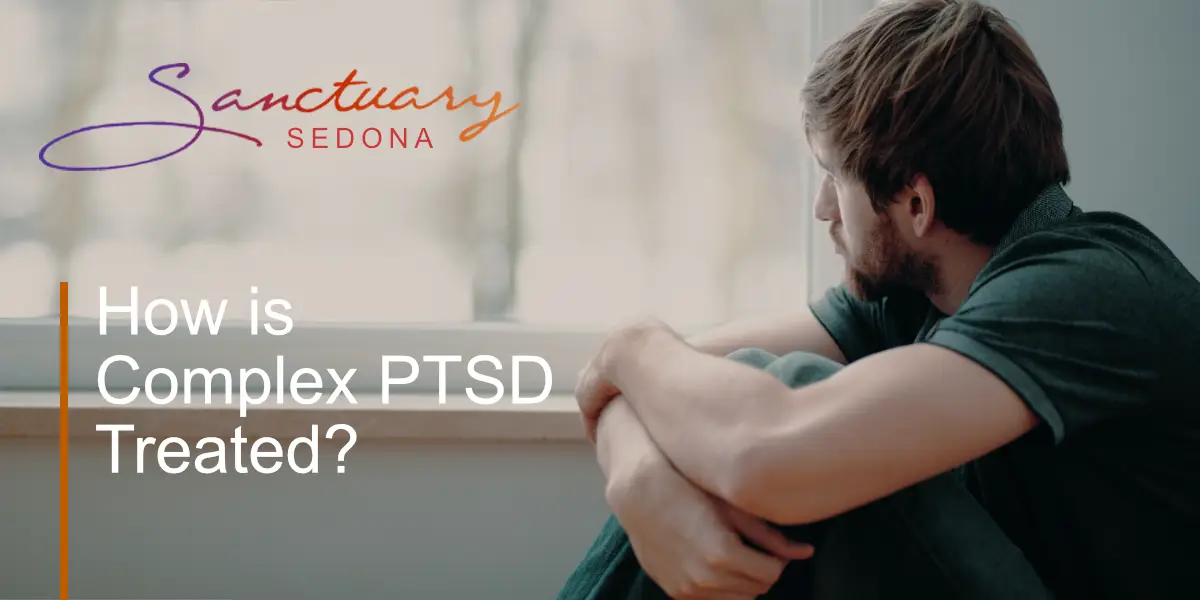If you’re living with complex PTSD, healing might feel impossible. But just because your trauma is complex doesn’t mean treatment has to be. Healing is possible through proven treatment methods that take place in a supportive setting. A holistic trauma treatment program can reduce your symptoms and resolve your trauma without making you feel unsafe.
The Four Components of Holistic C-PTSD Treatment
At The Sanctuary, we follow a four-step healing journey to treat your complex PTSD. Other treatment centers may just focus on symptom management. But we designed an integrated holistic treatment program to treat your issues at their core, so you can fully heal.
Shed Old Belief Systems
The first step in healing from complex trauma is releasing yourself from the beliefs that are holding you back.
A defining characteristic of C-PTSD is a negative self-view. Many people blame themselves or feel intense shame about what happened to them. But you are never to blame for your trauma. And moving past it requires working through feelings like guilt, embarrassment and in a safe, supported way.
Another core symptom of complex PTSD is having difficulty forming healthy relationships. You might find it hard to trust others, especially if someone you trusted is the cause of your trauma. But social support is crucial for healing from PTSD. So it’s important to free yourself of fear-based beliefs about the world around you if they’re holding you back from healthy connections.
Identify Shadow Aspects of Yourself
Shadow work, the second step of our holistic trauma treatment program, is the practice of reclaiming your darker parts. The purpose of this step is to identify and bring to light those hidden parts of you, so you can change the way you relate to them.
For example, C-PTSD can make it hard to control your emotions. Some people feel apathetic about everything, even things they used to be passionate about. Others may experience the opposite, blowing up over a minor issue. And if you’re not sure of where these feelings are coming from, it can be exhausting and confusing. By identifying the underlying reasons for feeling the way you do, you can change your own narrative.
If you have C-PTSD, turning inward or diving into your subconscious might sound intimidating. Maybe you’re afraid of what you’ll find there. Or you’ve been running away from those feelings since you can remember. But as long as your shadows remain hidden, they’re in control. By bringing your darkness to the light, you can examine and change how it influences you. You can gain control of your life again.
Envision a New Life
Next, you’ll work on imagining a life where you’re connecting with your true purpose, without your trauma holding you back. You get to ask yourself:
What would life look like if you healed your unresolved trauma?
What could you do for yourself and for the world?
How could you move beyond the hurt and into a life free of fear?
Sometimes, when you’re living with complex PTSD, survival is the goal. As one of our past clients explained, just getting to work every day took everything she had. She had nothing left to give beyond that. If that sounds familiar, envisioning a life where you serve your purpose can seem out of reach. But at this point in your healing, you’ve already done the hard work of shedding old beliefs. You’ve unearthed the hidden parts of yourself and changed how they control you. Now all you have to do is define what life after healing means for you.
Implement the Changes You’ve Made
The last step of our holistic C-PTSD treatment plan is to apply all the lessons you’ve learned. In this step, you get to start living the life you envisioned, healed and ready to connect with your life’s purpose. You’ve done hard work, and you know what you’re capable of. And now, you’re able to achieve what you’re seeking.
C-PTSD is overwhelming, and may make recovery feel out of reach. And while it certainly doesn’t happen overnight, with these four holistic steps as our guide, there’s a wealth of therapies that can treat your C-PTSD.
What Types of Treatments Exist for C-PTSD?
There are many ways to heal your trauma. And while some treatment centers focus on one or two, at The Sanctuary, we use an integrated, holistic approach that touches on all aspects of a whole person: mind, body, soul and spirit.
How To Heal From Complex PTSD:
Treatments for complex PTSD can include somatic experiencing, nutrition therapy, and movement and bodywork.
We hold our traumas in our bodies. It’s as if they physically imprint on us. For example, many people with PTSD live in a state of hypervigilance, where you’re constantly focused on potential threats. This can make a simple car backfiring trigger a physical response almost immediately. You might feel your heart rate increase, or you might drop to the ground without even knowing what you’re doing.
Because of this, it’s important that C-PTSD treatment includes therapies that work to physically release your trauma and heal your body. These include:
- Somatic experiencing, in which you feel and then learn how to manage the physical sensations resulting from your trauma
- Nutrition therapy, where we use a balanced diet and supplements to heal your gut-brain connection and encourage natural serotonin production
- Movement and bodywork, therapy techniques designed to help you let go of the trauma your body is holding onto
How To Recover From Complex PTSD
Recovering from complex PTSD can include treatments like eye movement desensitization and reprocessing, medication management, and ketamine-assisted treatment.
Many symptoms of C-PTSD are mental, including a negative self-view, and difficulty handling emotions. Plus, the same trauma that can cause complex PTSD can also lead to other mental health conditions like depression and anxiety.
For these reasons, treatment must include therapies that heal your mind, including:
- Eye movement desensitization and reprocessing (EMDR), wherein a therapist guides your eye movements to help you move your trauma into a less intense part of your memory
- Medication management, which can make your symptoms more manageable as you work to resolve your trauma, or reduce the amount of medications you’re taking
- Ketamine-assisted treatment, in which you can reduce your symptoms and open yourself to further healing with an IV infusion in a therapeutic setting
Reconnect With Your Soul After Trauma
Trauma affects your soul. If you’ve lived through chronic trauma, you might’ve learned it’s not okay to be yourself. And the only way to get back to your truest self, and live your life’s purpose, is by repairing the traumatic damage on your soul.
At The Sanctuary, we do this by speaking the languages of your soul: creativity and ritual. With creative therapies, you’ll learn to express your most genuine desires and purpose through music, art, poetry or even time in nature. And we use both ancient and modern ceremonies like guided meditation and fire and drum journeys to help you build rituals of your own so you can access all parts of your soul again.
Repair Your Spirit From Complex PTSD
Each of us is made up of energy, which connects to the larger energetic field. And trauma can block or unbalance your energy flow. These disruptions can lead to a host of physical and emotional issues, like C-PTSD.
It’s essential to heal your energy body to fully resolve your trauma. To do that, we use energy medicine and psychology to bring balance back to your body.
Our holistic, integrated approach to healing trauma means you have access to a range of therapies to try as part of your journey. Because everyone’s trauma is unique, your reaction to trauma is unique as well. That’s why it’s important to have options for treatment, especially if you’re struggling with co-occurring addiction.
Co-Occurring Treatment for C-PTSD and Addiction
Trauma is at the core of so many addictions and mental health issues. Complex PTSD in particular is associated with addiction because of how it affects your emotions. And because trauma underlies most addictions, it’s vital that your treatment program is trauma-informed for the safest, most effective healing possible.
The good news is that in holistic recovery, the process of healing from trauma and addiction is one and the same. For example, nutrition supports both addiction and trauma recovery because “there is no mental health issue without an underlying and predisposed gut issue.”
If you’re struggling with substance use as a result of your C-PTSD, you may not know where to start. But our immersive healing process offers total transformation, addressing all of your healing needs while providing hands-on comfort and care.
Where You Heal Matters
When looking for C-PTSD treatment, it’s not just the how that is important, but also the where. Exposure to trauma can make it very hard to feel safe.
One former C-PTSD client explained how she spent her entire life before treatment looking for ways to feel secure after her childhood trauma. She had held her breath for years, unable to let go. If you feel the same, residential treatment may seem intimidating. But that same client explained when she entered The Sanctuary, she was finally able to exhale for the first time.
Here, you’ll be able to heal in the tranquility of the Sedona desert, surrounded by beautiful nature. In our small community of equals, we function as a tight-knit family, with everyone supporting each other’s journey.
Through proven holistic treatment methods, a deep understanding of what you’ve been through, and a welcoming support system, you too can exhale.
Contact The Sanctuary to start your journey today.
Kelley Alexander JD. is the co-director of The Sanctuary at Sedona and has worked over the last decade to develop its innovative Integrative Addiction Recovery Program that has helped hundreds of clients to be recovered from addiction and co-occurring disorders. Through her pioneering work, Kelley and her team at The Sanctuary also work with clients to overcome issues related to codependency, anxiety, depression, and PTSD. A JD and former practicing attorney, Kelley holds a BA in World Religions and has done graduate work in psychology. She is an ordained minister, certified shamanic breathwork facilitator, and a graduate of the Four Winds Healing The Light Body School, the premier energy medicine program founded by Alberto Villoldo. Kelley has also been a student of Dr. Joe Dispenza since 2009. She is a member of the Association for Comprehensive Energy Psychology and the Institute for Holistic Addiction Studies. She is a frequent lecturer at seminars and conferences throughout the United States.
[email protected]


